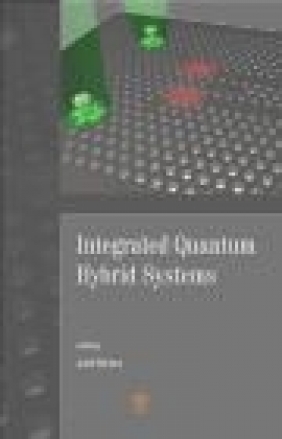Integrated Quantum Hybrid Systems
Janik Wolters
Integrated Quantum Hybrid Systems
Janik Wolters
- Producent: Pan American Health Organisation
- ISBN: 9789814463829
- Ilość stron: 292
- Oprawa: Twarda
Niedostępna
Opis: Integrated Quantum Hybrid Systems - Janik Wolters
Integrated quantum hybrid devices, built from classical dielectric nanostructures and individual quantum systems, promise to provide a scalable platform to study and exploit the laws of quantum physics. On the one hand, there are novel applications, such as efficient computation, secure communication, and measurements with unreached accuracy. On the other, hybrid devices might serve to explore the limits of our understanding of the physical world, that is, the formalism of quantum mechanics. Thus, optical quantum hybrid systems got into the focus of many researchers worldwide. This book gives a comprehensive yet lucid introduction to the exciting and fast-growing field of integrated quantum hybrid systems. It presents the theoretical and experimental fundamentals and then discusses several recent results and new proposals for future experiments. Illustrated throughout with excellent figures, the book also outlines the way for more complex devices to realize schemes to entangle distant quantum systems on-chip.1. Introduction Part I: Fundamentals of Quantum Optics 2. From the Classical to the Quantized Formulation 2.1 Charged Particles and Normal Modes 2.2 Classical Particle and Field Dynamics 2.2.1 Canonical Variables 2.2.2 Hamilton Equations 2.2.3 Coulomb Field 2.2.4 Space Related Variables 2.2.5 Radiation Related Variables 2.2.6 Maxwell Equations 2.2.7 Momentum Related Variables 2.2.8 Dipole Approximation 2.3 The Quantized Hamiltonian 3. Properties of the Quantized Electromagnetic Field 3.1 Field Observables 3.2 Fock States 3.3 Coherent States 3.4 Quasi Continuum and Density of States 4. Light-Matter Interaction 4.1 Second Order Perturbation Theory 4.1.1 Absorbtion 4.1.2 Emission 4.1.3 Photon Detection and Statistics 4.1.4 Excitation of Two Level Systems 4.1.5 Total Spontaneous Emission Rate 4.1.6 Steady State of the Two Level System 4.1.7 Dynamic Behavior of Two Level Systems 4.1.8 Photon Statistics and Two Level Systems 4.1.9 Three Level Systems 4.2 Coherent Interactions 4.2.1 Optical Bloch Equations 4.2.2 Analogy to Spins in Magnetic Fields 4.2.3 Steady State Solution 4.2.4 Rabi Oscillations 4.2.5 BlochVector 4.2.6 Undamped Rabi Oscillations with Detuning 4.2.7 StaticDecoherence 4.2.8 Measurement Induced Decoherence 4.2.9 The Quantum Zeno Effect 4.3. Three Level Systems 4.3.1 The LAMBDA-System 4.3.2 Stimulated Raman Transition 4.4 Cavity Quantum Electrodynamics 4.4.1 Cavity Modes 4.4.2 Jaynes-Cummings Model 4.4.3 One Photon Bloch Equations 4.4.4 Vacuum Rabi Splitting 4.4.5 Vacuum Rabi Oscillations and Purcell Effect Part II: Quantum Systems for Integration into Hybrid Devices 5. Quantum Dots 5.1 Quantum Dot Wavefunction and Level Structure 5.2 Experiments with Single Quantum Dots 5.2.1 Single Photon Source 5.2.2 Entangled Photon Source 5.2.3 Spin Qubit 6. Single Molecules 6.1 Fundamentals of Single Molecules 6.2 Experiments with Single Molecules 6.2.1 Room Temperature Single Photon Source 6.2.2 Optically Detected Magnetic Resonance 7. Color Centers in Diamond 7.1 Nanodiamond 7.2 Silicon-Vacancy Center in Diamond 7.3 Nitrogen-Vacancy Center in Diamond 7.3.1 Observation of Single Nitrogen-Vacancy Centers 7.3.2 Excited State Lifetime and Spectral Properties 7.4 Spectral Diffusion 7.4.1 Techniques for Measuring Spectral Diffusion 7.4.2 The Theory of Photon Correlation Inter- ferometry 7.4.3 Measurement of Spectral Diffusion by Photon Correlation 7.4.4 Results of Spectral Diffusion Measurements 7.5 Spin Physics of Nitrogen-Vacancy Centers 7.5.1 Orbitals and Triplet Levels 7.5.2 Singlet Levels and Spin State Detection 7.5.3 Optical Detection of Magnetic Resonances 7.5.4 Coherent Spin Manipulation 7.6 Simplified Model and Effect of Strain on Nitrogen-Vacancy Centers 7.7 Demonstration of the Quantum Zeno Effect Part III: Optical Microstructures 8. Electrodynamics in Media 8.1 Maxwell's Equations in Dielectric Media 8.2 Linear Isotropic Dielectrics 8.2.1 Electric Field per Photon 8.2.2 The Classical Wave Equation 8.3 Spontaneous Emission in Uniform Dielectrics 8.4 Electrodynamics as an Eigenvalue Problem 8.5 Symmetries in Dielectric Strucutures 8.5.1 Mirror Symmetries 8.5.2 Translation Symmetries 8.6 Total Internal Reflection 9. Immersion Microscopy 9.1 Liquid Immersion Microscopy 9.2 Solid Immersion Microscopy 10. Index Guiding Structures 10.1 Guided Modes in Infinite Dielectric Slabs 10.1.1 Symmetry Considerations 10.1.2 Mode Guiding 10.2 Strip Waveguides and Fibers 10.3 Whispering Gallery Modes in Disk Resonators 10.3.1 Fabrication of Disk Resonators 10.3.2 Measurement of the Mode Structure of Disk Resonators 11. Photonic Crystals 11.1 Introduction to Photonic Crystals 11.2 Photonic Crystal Slabs 11.2.1 Geometry and Band Structure 11.2.2 Fabrication 11.3 Photonic Crystal Waveguides 11.4 Photonic Crystal Cavities 11.4.1 L3 Cavity 11.4.2 Optimized L3 Cavity 11.4.3 Modulated Waveguide Cavities 11.5 Experiments with Photonic Crystal Cavities 11.5.1 Analysis by Intrinsic Fluorescence 11.5.2 Analysis by Polarization Properties 11.6 Tuning of Photonic Crystal Cavitites 12. Applications of Photonic Crystal Cavities 12.1 Narrow-Band Optical Filter 12.2 Refractive Index Measurement in Ultra Small Volumes 12.2.1 Experimental Method 12.2.2 Temperature Dependency of the Refractive Index of GaP 12.2.3 Influence of the Temperature on the Quality Factor 12.3 Thermo-Optical Switching 12.3.1 Theoretical Predictions 12.3.2 Experimental Implementation Part IV: Coupling of Quantum System to Optical Microstructures 13. Weak Coupling Regime 13.1 Quantum Dots 13.2 Color Centers in Diamond 13.2.1 Top-Down Integration 13.2.2 Bottom-Up Integration 13.3 Applications of NV Centers in the Weak Coupling Regime 14. Strong Coupling 14.1 Strong Coupling Regime with Quantum Dots 14.2 Strong Coupling with NVs in Diamond 15. Cavity Enhanced Entanglement 15.1 Probabilistic Entanglement 15.1.1 A Heralded High Fidelity Entanglement Scheme 15.1.2 Heralded Entanglement with NV Centers 15.2 Deterministic Entanglement 15.2.1 The Model System 15.2.2 Effective Hamiltonian Approach 15.2.3 Lindblad Approach 15.2.4 Influence of the Detunings and Spectral Diffusion 15.2.5 Inuence of Q-factor and Cavity Coupling 16. Conclusions and Outlook 16.1 Summary and Conclusions 16.2 Outlook Acknowledgments Own Contributions Bibliography List of Figures List of Tables List of Abbreviations Index
Szczegóły: Integrated Quantum Hybrid Systems - Janik Wolters
Tytuł: Integrated Quantum Hybrid Systems
Autor: Janik Wolters
Producent: Pan American Health Organisation
ISBN: 9789814463829
Ilość stron: 292
Oprawa: Twarda
Waga: 0.54 kg




















